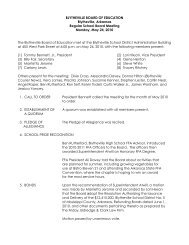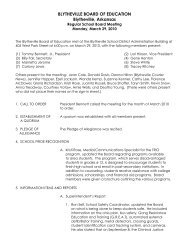District-Wide Safe Schools and Crisis Plan - Blytheville Public Schools
District-Wide Safe Schools and Crisis Plan - Blytheville Public Schools
District-Wide Safe Schools and Crisis Plan - Blytheville Public Schools
Create successful ePaper yourself
Turn your PDF publications into a flip-book with our unique Google optimized e-Paper software.
H.5. DOs <strong>and</strong> DON'Ts Related to Suicidal Threats<br />
The publications of many organizations <strong>and</strong> governmental agencies contain advice for people who want to<br />
help suicidal youngsters. That advice is summarized below.<br />
DOs<br />
LISTEN to what the student is saying <strong>and</strong> take her/his suicidal threat seriously. Many<br />
times a student may be looking for just that assurance.<br />
OBSERVE the student's nonverbal behavior. In children <strong>and</strong> adolescents, facial<br />
expressions, body language, <strong>and</strong> other concrete signs often are more telling<br />
than what the student says.<br />
ASK whether the student is really thinking about suicide. If the answer is "yes,"<br />
ask how she/he plans to do it <strong>and</strong> what steps have already been taken. This<br />
will convince the student of your attention <strong>and</strong> let you know how serious the<br />
threat is.<br />
GET HELP by contacting an appropriate CRT member. Never attempt to h<strong>and</strong>le a<br />
potential suicide by yourself.<br />
STAY with the student Take the student to a CRT member <strong>and</strong> stay with the<br />
student for awhile. The student has placed trust in you, so you must help<br />
transfer that trust to the other person.<br />
DON'Ts<br />
DON'T leave the student alone for even a minute.<br />
DON'T act shocked or be sworn to secrecy.<br />
DON'T underestimate or brush aside a suicide threat ("You won't really do it; you're<br />
not the type"), or try to shock or challenge the student ("Go ahead. Do it.").<br />
The student may already feel rejected <strong>and</strong> unnoticed, <strong>and</strong> you should not add<br />
to that burden.<br />
DON'T let the student convince you that the crisis is over. The most dangerous time<br />
is precisely when the person seems to be feeling better. Sometimes, after a<br />
suicide method has been selected, the student may appear happy <strong>and</strong> relaxed.<br />
You should, therefore, stay involved until you get help.<br />
DON’T take too much upon yourself. Your responsibility to the student in a crisis is<br />
limited to listening, being supportive, <strong>and</strong> getting him/her to a trained<br />
professional. Under no circumstances should you attempt to counsel the<br />
student.<br />
57
















